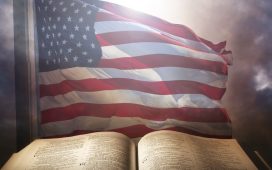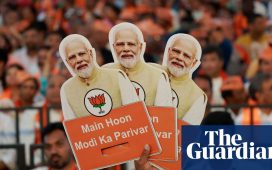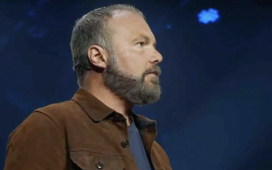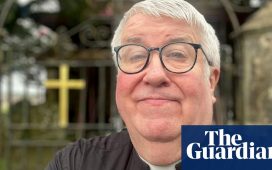With climbing vaccinations and dwindling virus cases, Americans from Honolulu to Sumter, S.C., have begun to return to the things they did before — the nights out, religious services and annual traditions that made life richer. But after a year of isolation, it has all been a bit uncertain, both familiar and not quite.
“Even doing normal isn’t normal,” said Amy Holson-Schwartz, 37, who took her family to an annual sheepshearing event on a farm in Vermont that was canceled last year because of the coronavirus pandemic. She said it was odd to see other children’s uncovered faces in public and watched as her 18-month-old daughter, whose 10-word lexicon includes “mask,” gawked at other babies.
“She’s had no interaction with other kids,” Ms. Holson-Schwartz said.
Photographers for The Times documented Americans re-emerging in all 50 states in recent weeks. The approach to reopening has been much like the nation’s patchwork response to the virus: conflicting guidance, competing narratives and Americans left to gauge their own comfort levels.
Ashlee Wolsky, 23 and fully vaccinated, felt comfortable attending the reopening of Arthur’s Barn in Arthur, N.D., where revelers flipped one another over on the crowded floor of the honky-tonk. The old routine of dressing up to go out on a Friday night felt newly charged. “It had a different level of excitement that I haven’t felt before,” she said.
She delighted in seeing an older couple she recognized, dancing. “You don’t know anything about them, but it’s a familiar face in the barn,” she said. “It’s a touch of normal.”
— Aidan Gardiner
Like so many other performers, musicians who played in the McClurg jam moved their mountain music sessions outdoors. In November, cold weather and safety concerns halted the weekly jams that have been going for decades, but a warm spring brought the music back.
“There’s a lot of good musicians in these hills if you can just get ’em out,” said Alvie Dooms, far left.
Though major productions on America’s premier stages most likely won’t happen for several months, easing restrictions on crowd sizes and live entertainment have allowed many performers to return to familiar venues.
In Oklahoma, the Tulsa Performing Arts Center welcomed an audience of 600 into its nearly 2,400-seat theater on May 2 — its first in-person performance since early 2020 — to watch “Greenwood Overcomes,” an opera marking the centennial of the massacre of Black people living in Tulsa’s then-affluent Greenwood neighborhood by a white mob.
New Orleans allowed bands to resume indoor performances on March 12, but left some restrictions on wind instruments in place, forcing some bands that played at the venue Favela Chic that night to change their usual lineup.
Actors performed “Romeo and Juliet” in masks for Kentucky Shakespeare’s celebration of the playwright on April 23, the anniversary of his death. The annual event was canceled last year.
Cameron Barner, left, and Ben Hamilton farm oysters off their company boat, Ralph, in Maine. Their business was hit hard by restaurant closures and few customers at the ones that remained open.
“We are really excited to have a comeback with full force, and have people vaccinated, and have that appetite for oysters be insatiable again,” Mr. Barner said.
David Steckel, a conductor on the Mount Cuba Meteor, checked in on passengers before the train pulled out of the station in Delaware. The Wilmington and Western Railroad, an operating railroad museum, stopped operations for several months, before reopening to limited capacity that increased to 50 percent in April.
Lockdowns devastated businesses throughout the country. There are still 8.2 million fewer jobs than at the start of the pandemic. The dizzying whipsaw of regulations forced many restaurants to limit capacity and often lay off staff members. Many restrictions are now being lifted, as they have in New York, where indoor dining capacity was recently increased to 75 percent.
Those changes will most likely mean more business for the food industry, but some safety precautions may remain, as they have in other industries.
Some quiet projects have resumed too. In St. Ignatius, Mont., Sxwlekws Bell, left, Willie Stevens, center, and Gary Stevens restarted work on a canoe that they hadn’t worked on since 2019.
“It sat for a year, but at least now the wood is dried out,” Mr. Stevens said.
Eddie Osman, 49, and his wife, Regina Osman, 47, celebrated getting their first dose of a vaccine over chocolate cake, espresso and tea on April 16. It was their first meal in a restaurant since last spring.
The pandemic was a blow to the food industry. Many restaurants drastically changed how they operated. Many others couldn’t survive. In some cases, people clamored for their favorite eateries to reopen, resulting in the kinds of clusters of Covid-19 infections that led to the initial lockdowns.
But, with increased vaccinations and restrictions rolled back in most states, Americans are breaking bread together again.
In Washington, Lakisha Howard hugged her husband, Wendell, during a Mother’s Day cruise with their family on May 9.
“My husband proposed to me 15 years ago on this boat,” she said. “He re-proposed to me today and all the kids kept it a secret.”
Sharon Nicholls and Al Simons kissed during a performance by the band BeefStu in Concord, N.H., on April 24.
“We learned, out of this, don’t waste any time,” Ms. Nicholls said.
The virus’s sudden appearance led many competitions to halt last spring. Play eventually resumed, sometimes with profound changes, like professional athletes retreating into “bubbles” meant to protect them from the threat of infection.
Convoluted regulations have begun to recede for younger athletes who often risked infection for the social, emotional and academic benefits of competition.
Kreed Sanderson, a high school student, wrestled a steer at the Idaho District 7 seasonal rodeo April 24. Fewer spectators watched last year’s rodeo in early May when the state was reporting close to 30 new virus cases a day.
Rules for gyms are easing too. In Connecticut, where Ester Sanches-Naek ran on a treadmill in an empty Club Fitness, capacity limits were lifted in March. Still, few have returned to her gym amid a boom in outdoor running.
Maureen Nafula, right, 13, worked on her car before racing in the Columbus Soap Box Derby Spring Rally on April 24. Racers competed for a spot in the All American Race in Akron, Ohio, in July. The Columbus race, which was canceled in 2020, had run continuously since 1962. Until last year, the Akron championship races hadn’t been canceled since World War II.
Danny Pearson and Patrick Hegarty cheered for the Philadelphia Union, a Major League Soccer team, at their home opener on April 24. Last year, the league played a truncated season.
Casey Jones applied makeup to Selena Smith during a bodybuilding competition in South Carolina on April 24. Organizers required temperature checks and safety forms from everyone at the event. Only competitors were allowed to forgo masks.
In Chicago, Rosie McGee, 94, left, and Patricia Butts, 65, embraced at the entrance of Ebenezer Missionary Baptist Church on May 2. It was Ms. McGee’s first in-person service at the church since the pandemic began.
“It felt like coming home,” she said.
Early in the pandemic, hard-hit states like New York and California imposed strict rules on the types of religious gatherings that drove many early infections. But ritual remained a powerful draw, especially in a difficult time, and the Supreme Court repeatedly struck down such restrictions. On April 9, the court struck down California’s rules against religious gatherings in private homes.
Now, ancient traditions mingle with new precautions: temperature checks, safety questionnaires and pews marked with painter’s tape, as they were at Church of Christ Congregational in Newington Conn., where Thomas Weeden led the service from behind a transparent barrier.
At the South Metro Islamic Center in Minnesota, people were encouraged to wash elsewhere, rather than at the mosque as is typical, before visiting the mosque, where blue circles on the carpet designated space for prayer rugs.
Ashlee Wolsky attended the reopening of Arthur’s Barn in North Dakota on April 16 with friends. She grew up in the area hearing older neighbors talk about it and first visited when she was a freshman in college.
“Life is never going to be the same after a global pandemic,” she said. “But we can make it close to as enjoyable as before.”
Phillip Burgess, center, posed with his mother, Prof. Sheron Fraser-Burgess, left, and father, the Rev. Darryl Burgess, after the commencement ceremony at Ball State University on May 8.
“Today, I was humbled,” Dr. Fraser-Burgess said. “For us to see him walk across that stage, for him to do that, it means so much.”
There are paintings by Monet to ponder in Boston, llamas to hug again at the Portland Night Market and saplings to retrieve from the annual tree giveaway in San Juan, P.R., that returned after last year’s cancellation.
Children spun cartwheels in front of an ’80s cover band in Palmer, Alaska. Bikers roared through Daytona Beach, Fla. And families met dinosaurs at a balloon festival in Goodyear, Ariz.
Kira Mildenstein, 41, and her husband, Jon, took their five children to an annual tulip festival in Lehi, Utah, on April 24 for their first family outing since last spring. Attending had been a kind of family tradition, but she and her husband paused this year to weigh the risks and their own comfort. At the festival she noticed all the differences: fewer people, masks, dry water fountains and her own wariness about her children touching things.
“It was weird because so many people were treating it like any other day,” she said. “There was almost an eerie quality to it because it felt normal but still not normal at the same time.”
In Nebraska, the queen’s court wore anachronistic masks during a renaissance festival on May 9.
In South Dakota, Brynn Henning and Brooke Scheitler, both 8, paused to laugh during the Great Cardboard Boat Race at the Midco Aquatic Center.
Top photographs: Columbus, Ohio: Maddie McGarvey; Arthur, N.D.: Tim Gruber; Burbank, Calif.: Philip Cheung; El Paso: Ivan Pierre Aguirre; New York: An Rong Xu; Chicago: Taylor Glascock; Knoxville, Tenn.: Shawn Poynter; Rigby, Idaho: Natalie Behring; Waterford, Miss.: Timothy Ivy; Ronan, Montana: Tailyr Irvine.
Produced by Sarah Almukhtar, Clinton Cargill, Heather Casey, Sarah Eckinger, Rebecca Halleck and Virginia Lozano.




